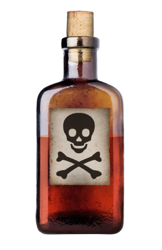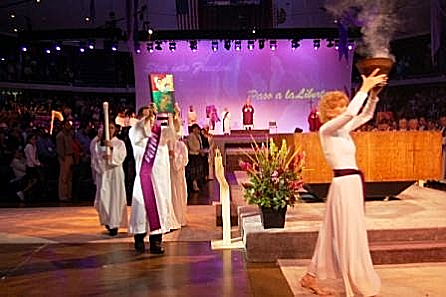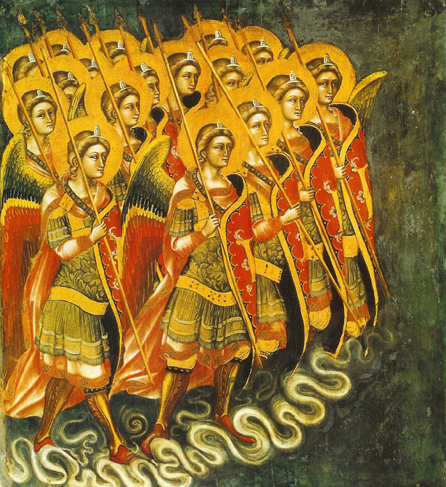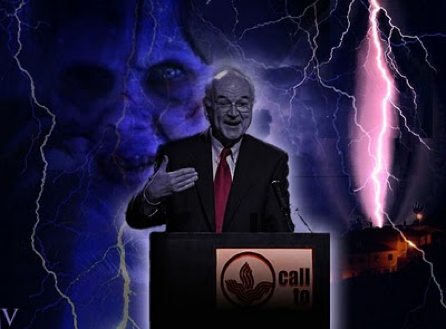Marking 30 Years of Priesthood: If I Knew Then What I Know Now!
 On his 30th anniversary of priesthood ordination, Fr. Gordon MacRae writes poignantly of a priesthood in freedom, in prison, and in sacrifice.Well, I'm back - even though I've never left - and my prison cell looks less cluttered after having disposed of reams of paper or thought I no longer needed. I still can't find anything, however, and even though I've missed writing over the last month, I have also appreciated the break. I owe a great debt of gratitude to Father George David Byers, Monsignor Michael, Father James Valladares, and David F. Pierre, all of whom stepped in with their prodigious writing skills to rescue you from my reruns in the month of May. I also thank Suzanne, TSW's very accomplished publisher and editor, who got no break at all.They deserve a standing ovation for the many ways they place their gifts and skills in service of the Church, the truth, and justice. I can only paraphrase Jack Nicholson from the film, "As Good as it Gets" - They make me want to be a better priest!And speaking of which, this week on June 5/6, 2012, I mark my 30th Anniversary of priesthood ordination and First Mass. I have described the day I was ordained a number of times on These Stone Walls, most notably in two posts, "Going My Way" and "In the Year of the Priest, the Tale of a Prisoner.” I have also many times described the challenges of priesthood spent in prison. Among all that I have written on that score, however, what I would most want readers to re-visit on my 30th anniversary of priesthood is "The Sacrifice of the Mass Part I" and "Part II." I could end this post right here because all I would want you to know of my thirty years as a priest is contained right there.None of what I have endured in prison means anything at all without the freedom to sacrifice. I didn't get this when I was first ordained. It was only when my own crosses became many and great that I began to understand the priesthood of sacrifice. It is what author, George Weigel described in "The Priest: Icon of Christ, Enabler of Sanctity." I mentioned this same essay in "The Expendables: Our Culture's War Against Catholic Priests" in April, but a few lines from it jumped out at me again for this post:
On his 30th anniversary of priesthood ordination, Fr. Gordon MacRae writes poignantly of a priesthood in freedom, in prison, and in sacrifice.Well, I'm back - even though I've never left - and my prison cell looks less cluttered after having disposed of reams of paper or thought I no longer needed. I still can't find anything, however, and even though I've missed writing over the last month, I have also appreciated the break. I owe a great debt of gratitude to Father George David Byers, Monsignor Michael, Father James Valladares, and David F. Pierre, all of whom stepped in with their prodigious writing skills to rescue you from my reruns in the month of May. I also thank Suzanne, TSW's very accomplished publisher and editor, who got no break at all.They deserve a standing ovation for the many ways they place their gifts and skills in service of the Church, the truth, and justice. I can only paraphrase Jack Nicholson from the film, "As Good as it Gets" - They make me want to be a better priest!And speaking of which, this week on June 5/6, 2012, I mark my 30th Anniversary of priesthood ordination and First Mass. I have described the day I was ordained a number of times on These Stone Walls, most notably in two posts, "Going My Way" and "In the Year of the Priest, the Tale of a Prisoner.” I have also many times described the challenges of priesthood spent in prison. Among all that I have written on that score, however, what I would most want readers to re-visit on my 30th anniversary of priesthood is "The Sacrifice of the Mass Part I" and "Part II." I could end this post right here because all I would want you to know of my thirty years as a priest is contained right there.None of what I have endured in prison means anything at all without the freedom to sacrifice. I didn't get this when I was first ordained. It was only when my own crosses became many and great that I began to understand the priesthood of sacrifice. It is what author, George Weigel described in "The Priest: Icon of Christ, Enabler of Sanctity." I mentioned this same essay in "The Expendables: Our Culture's War Against Catholic Priests" in April, but a few lines from it jumped out at me again for this post:
"The Catholic priest is set apart from the world for the world's sake. In a culture like ours, his life is a sign of contradiction to much of what the world imagines to be true . . . His being different is not an end in itself, an indulgence in idiosyncrasy. The priest is a sign of contradiction so that the world can learn the truth about itself and be converted."
THE COURAGE TO SACRIFICEI remember vividly the very moment I first envisioned myself as a priest. It was 1968, a year of immense upheaval. If you weren't around then, or are too young to remember, you might want to read a chilling account of 1968 by Monsignor Charles Pope entitled, "1968 - A Fateful and Terrible Year Where Many in the Church Drank the Poison of this World."He captured well the reality of 1968, and the decade that was the backdrop for my generation of priests.Monsignor Charles Pope was seven or eight years old in 1968, but I was fifteen, and had just begun attending Mass for the first time in my life. Monsignor Pope described that year as "a cultural tsunami from which we have not yet recovered." It was in the very middle of that cultural tsunami that I first envisioned myself as a priest. In part, at least, the idea of priesthood might even have been a reaction to that year. My first thought of priesthood came not during a Mass, however, or in the company of any of the priests I knew. It came while I was watching a film, but today I cannot recall what film that was. As a prisoner, I just don't have the means to research such a thing but it contained a scene that I could never forget.It was taking place at the outbreak of World War II as Hitler's Nazi regime spread over all of Western Europe. The setting seemed to be a Catholic seminary. As the Nazis marched onto the grounds to storm the buildings, everyone fled for their lives; everyone, that is, except two priests.Dressed in their cassocks, they risked their lives to race to the seminary chapel where they opened the Tabernacle to quickly consume the Body of Christ because of their fear of desecration by the invading Nazis. As everyone else fled from the cavernous building, the two priests put their faith first and their safety last.After consuming all the hosts in the Tabernacle, they were too late to escape. They were taken prisoner, and suffered unspeakable abuses while their lives were bartered for concessions from the Vatican - concessions that could not have been made. The two priests suffered terribly.The mindset of 1968 saw those two self-sacrificing priests as fools - clowns in cassocks who defied the values of this emerging "me-first" generation with the foolish sacrifice of their freedom and their lives, and for what? For a tenet of faith that the Western World was on the very verge of mocking anyway? The very idea of priestly sacrifice is something our culture has come to despise, and the real test of Catholic faith and the Catholic faithful - including priests - is the extent to which we have capitulated to this cultural "me-first" evolution that saw its birth in 1968.The film depicted well something that I described recently in "Accommodations in the Garden of Good and Evil." It depicted the power of sacrifice for what we believe, and the great threat posed to faith when the concept of sacrifice is diminished by our culture of selfishness.At the age of fifteen, new to the life of the Church beyond my family's tradition as twice-a-year marginal Catholics, my eyes were opened and I saw those two priests for what they truly were: heroes. They were courageous men ready to lay down their lives for belief in something greater than their own selves. It was my very first vision that the Church is called not to emulate culture, but to challenge it. As George Weigel wrote:
My first thought of priesthood came not during a Mass, however, or in the company of any of the priests I knew. It came while I was watching a film, but today I cannot recall what film that was. As a prisoner, I just don't have the means to research such a thing but it contained a scene that I could never forget.It was taking place at the outbreak of World War II as Hitler's Nazi regime spread over all of Western Europe. The setting seemed to be a Catholic seminary. As the Nazis marched onto the grounds to storm the buildings, everyone fled for their lives; everyone, that is, except two priests.Dressed in their cassocks, they risked their lives to race to the seminary chapel where they opened the Tabernacle to quickly consume the Body of Christ because of their fear of desecration by the invading Nazis. As everyone else fled from the cavernous building, the two priests put their faith first and their safety last.After consuming all the hosts in the Tabernacle, they were too late to escape. They were taken prisoner, and suffered unspeakable abuses while their lives were bartered for concessions from the Vatican - concessions that could not have been made. The two priests suffered terribly.The mindset of 1968 saw those two self-sacrificing priests as fools - clowns in cassocks who defied the values of this emerging "me-first" generation with the foolish sacrifice of their freedom and their lives, and for what? For a tenet of faith that the Western World was on the very verge of mocking anyway? The very idea of priestly sacrifice is something our culture has come to despise, and the real test of Catholic faith and the Catholic faithful - including priests - is the extent to which we have capitulated to this cultural "me-first" evolution that saw its birth in 1968.The film depicted well something that I described recently in "Accommodations in the Garden of Good and Evil." It depicted the power of sacrifice for what we believe, and the great threat posed to faith when the concept of sacrifice is diminished by our culture of selfishness.At the age of fifteen, new to the life of the Church beyond my family's tradition as twice-a-year marginal Catholics, my eyes were opened and I saw those two priests for what they truly were: heroes. They were courageous men ready to lay down their lives for belief in something greater than their own selves. It was my very first vision that the Church is called not to emulate culture, but to challenge it. As George Weigel wrote:
"The reform of the priesthood cannot mean making Catholic priests more like Anglican, Lutheran, Presbyterian, Methodist, or Unitarian clergy. It can only mean a reform in which Catholic priests become more intensely, intentionally and manifestly Catholic."
DISMAL FOREBODINGSBut make no mistake, we will suffer for it. The signs are all around us, and there is no escaping it. Our culture is in for some very hard times. The role of the Church and priesthood in Western Culture is going to be severely tested, and we stand at the precipice. Much of what we have taken for granted in terms of freedoms and rights is about to fall from under us. We are on the verge of cultural disaster, and the faith that our world now laughs at will – if it stands fast – usher the world through another Dark Age.

As I watched that great film at the age of fifteen, I could not help but wonder what I would do in a circumstance like that Nazi invasion. Would I run for my life? Or would I race to preserve the Body of Christ from desecration at the cost of my life?The years and decades to follow would never test me in a single defining moment as the Nazi invasion tested the two priests in that film. In time, however, I would come to know the cost of discipleship in my priesthood, and I would be asked to pay it to preserve the truth. Long time readers of These Stone Walls know that I am paying it now.At age fifteen, when my vocation to priesthood was conceived in the midst of a cultural tsunami, I had no delusions about myself, no adolescent fantasies that I would somehow be the Captain America of the priesthood.Didn’t happen! But for days after watching that film about the Nazi invasion, I struggled with that chapel scene, and with what I might have done in that same circumstance. I even dreamed one night that I fled for my life from the pursuing Nazis, and awoke feeling disappointed with what felt like the inevitable truth about myself. My nightmare was that, like Saint Peter before me, I betrayed Christ to save myself. I knew I wanted a life that stood for something beyond the me-first world all around me, but I wasn't sure I had the courage for a life that stood apart.I just didn't know how to challenge my own instinct for self-preservation. None of us knows until the battle is upon us.And even today, after 18 years as a falsely accused priest in prison, I still struggle with the challenge of being an imperfect man and a flawed priest in the most awful of circumstances. My only remedy for this is something I wrote in my Holy Week post in April:
"Some TSW readers might wish for a different version, but I cannot write that I would have heroically thrust the Cross of Christ upon my own back. Please rid yourselves of any such delusion. Like most of you, I have had to be dragged kicking and screaming into just about every grace I have ever endured. The only hero at Calvary was Christ. The only person worth following up that hill - up ANY hill - is Christ. I follow Him with the same burdens and trepidation and thorns in my side as you do. So don't follow me. Follow Him."
EXTRAORDINARY CIRCUMSTANCESAs Monsignor Michael described himself in "The Red Blood of the Martyr," I, too, am just an ordinary priest. I have no special gifts at all, but I am an ordinary priest in extraordinary circumstances. Prison, especially being in prison for eighteen years without having actually committed a crime, qualifies as an extraordinary circumstance for any priest. Monsignor Michael cited that mine is a voice that "from the depths of his prison, dares to speak the truth." I accept no accolades for that. Neither priesthood, nor the truth, should be applauded for their very existence. Anyone who comes to the priesthood asking, "What's in this for me?" has no true vocation. Anyone who comes to the priesthood as a source of admiration and popularity should look elsewhere.

Last year, Joan Frawley Desmond, an editor for the National Catholic Register, joined a Franciscan University pilgrimage to Poland and wrote of it in a three-part journal for the Register. Her third installment, "A Pilgrim at Auschwitz," described the reality of that horror. I described it as well in "Saints and Sacrifices: Maximilian Kolbe and Edith Stein at Auschwitz."I fear sometimes that such articles are not widely read because they are painful, and indeed they are. But we must not look away, and we must not fail to see the abiding hope that arises in the midst of such pain and the immensity of its sacrifices. Joan Frawley Desmond quoted Blessed Pope John Paul II in declaring that Saint Maximilian Kolbe is "the patron saint of our difficult century." He is also the patron saint of These Stone Walls, and of prisoners.Our good friend, Father George David Byers, recently sent me a printed copy of his May 1, 2012 post by guest author, Dawn Eden on Holy Souls Hermitage entitled "St. Maximilian Kolbe: ‘Only Love is Creative.' " Dawn Eden is the author of a compelling new book, My Peace I Give You: Healing Sexual Wounds with the Help of the Saints. I plan to write much more about this healing gift to victims of abuse very soon.In her Holy Souls Hermitage post, Dawn Eden wrote about Father Maximilian Kolbe's "freedom" while in that horror of a prison at Auschwitz. He was free to sacrifice, and that sacrifice saved another at the price of his own mortal life in extraordinary circumstances.My 30th anniversary of priesthood in extraordinary circumstances could feel hopeless under the standards of this world and its self-serving culture. But the image of Saint Maximilian Kolbe that I described in my very first posts on These Stone Walls is still above the mirror in my prison cell. I cannot see myself without also seeing this prisoner-priest who guides me daily through the foreign land of prison. He defines my priesthood and the necessity of its sacrifices. In this, I'm giving the last word to the NC Register's Joan Frawley Desmond:
"But there is another lesson to be learned at Auschwitz. In every circumstance, no matter how desperate, we have a measure of freedom to love, to hope, and to believe. At Auschwitz, amid fear, death and suffering, Christ the Redeemer remained present to all who joined their sufferings to his own passion and death on the cross . . . We sought the intercession of the saints who perished here, and for the grace we need to follow their holy example." (NC Register, "A Pilgrim at Auschwitz," October 23, 2011).
As I lay prostrate before that altar on June 5, 1982, I had no idea of the grace of sacrifice that might be called upon for me to be a priest in the modern world. And the truth is - God help me - that if I knew then what I know now, I still could not flee for my life. I place my thirty years of grace and sorrow and sacrifice as a priest at the feet of Saint Maximilian Kolbe, forever a prisoner-priest.![]()